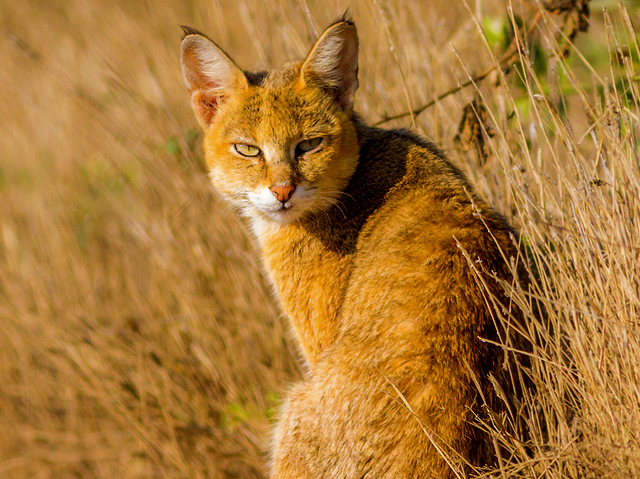Category : Mammals Share
Scientific Name : Felis chaus Schreber
Created By: Abhishek Bhor, Department of Botany, Annasaheb Awate Arts, Commerce and Hutatma Babu Genu Science College, Manchar
Created On: 18-09-2022
Specimen Information
Common Name(s):रान मांजर, Jungle Cat
Synonym(s): Felis catolynx Pallas F. erythrotus Hodgson F. rüppelii von Brandt
Family: Felidae
Status: LC
Description
Habitat Jungle cats prefer habitats near water with dense vegetative cover but can be found in a variety of habitats including deserts (where they are found near oases or along riverbeds), grasslands, shrubby woodlands and dry deciduous forests, as well as cleared areas in moist forests. They are commonly found in tall grass, thick brush, riverside swamps, and reed beds. Physical Description Jungle cats range in size from 70 to 120 cm long and 35 to 38 cm tall. They weigh from 4 to 16 kg. Adult males are larger and heavier than adult females. Throughout their range, significant variation in mass occurs. For example, in west Israel, they weigh 43% more than those in east India. This is likely due to increased competition between different cat species in the east. Jungle cats have long, slim faces with white lines above and below their bright yellow eyes with a dark spot just below each eye near the nose. They have long rounded ears, with a distinctive tuft of hair at the tips. Jungle cats have relatively short tails, about 1/3 of their total body length, which have several dark rings along its length and a black tip. Their coat color varies from a reddish or sandy brown to tawny grey. Black jungle cats are regularly seen in southeastern Pakistan and India. Kittens may be striped and spotted, however, these markings typically fade with age and are only retained on the fore and hindlimbs. The muzzle, throat, and belly of the jungle cat are a pale cream color, and their winter coat is darker and denser than their summer coat. Reproduction Jungle cat mating season is marked by the shrieks and fighting of male cats. Vocalization rates of males and females increases prior to copulation. Intense mew calls are used by both genders to attract potential mates. They also scent mark territorial boundaries, which may help them find and locate potential mates. Male and female jungle cats may have multiple different mates throughout their lives. Lifespan In captivity, jungle cats live an average of 15 years, but have been known to live up to 20 years.


